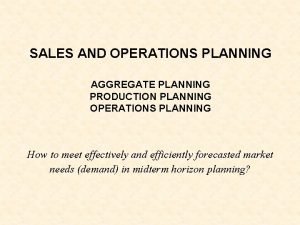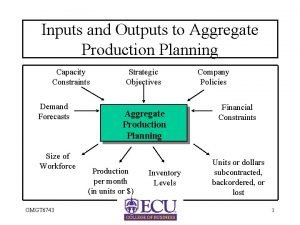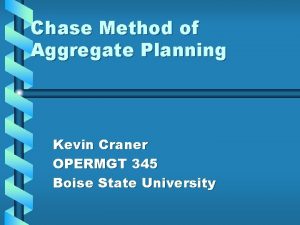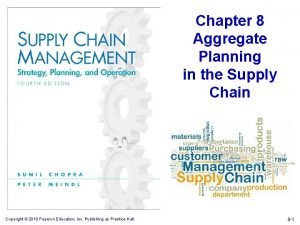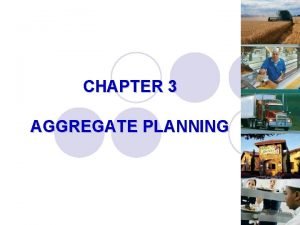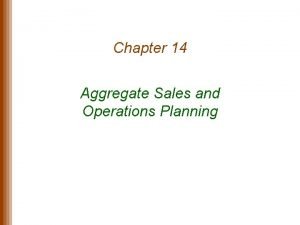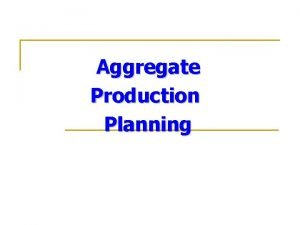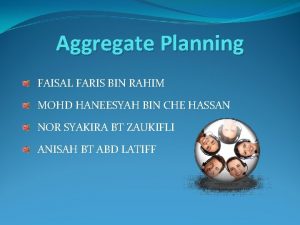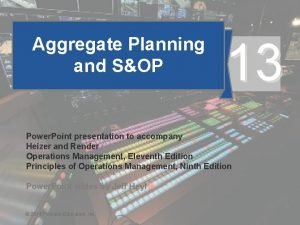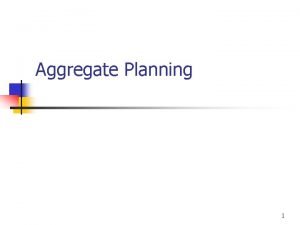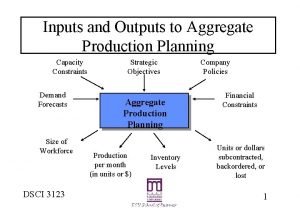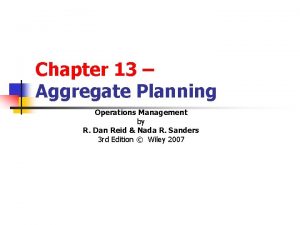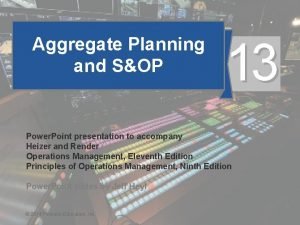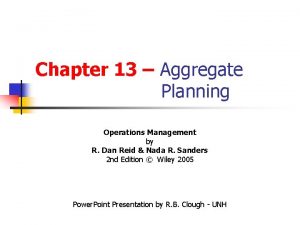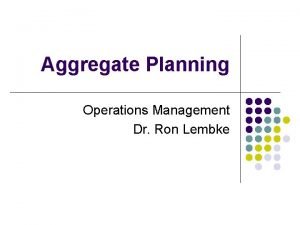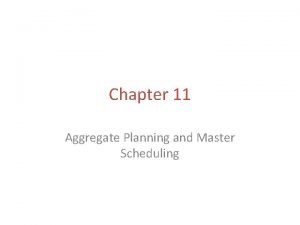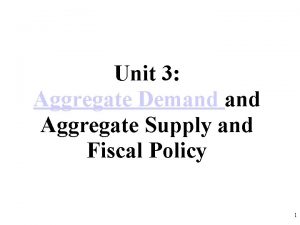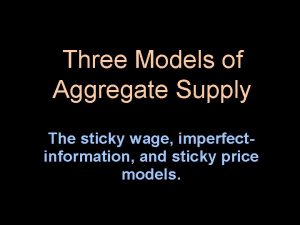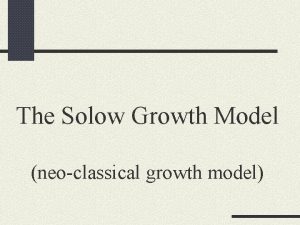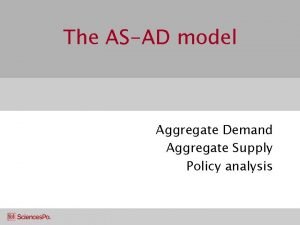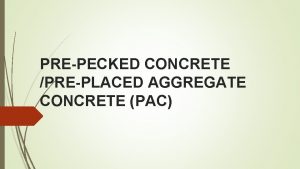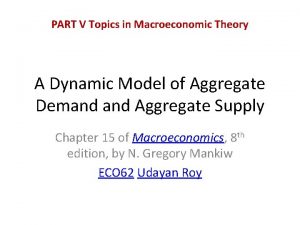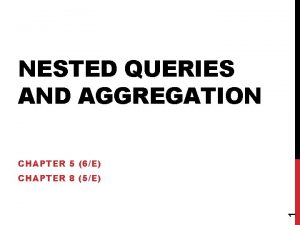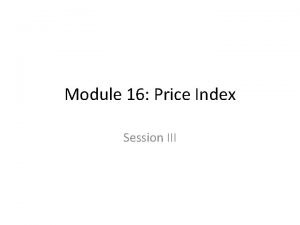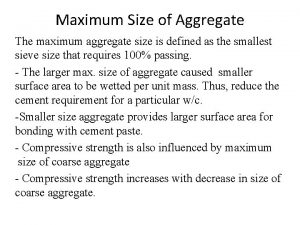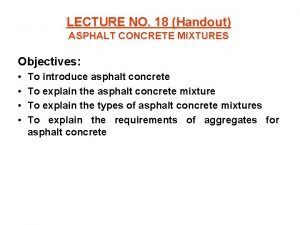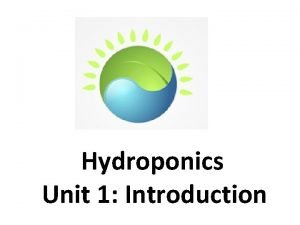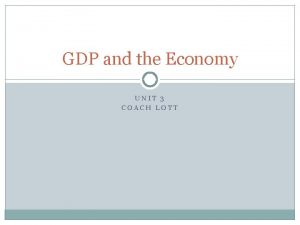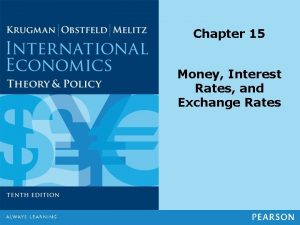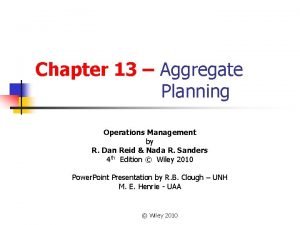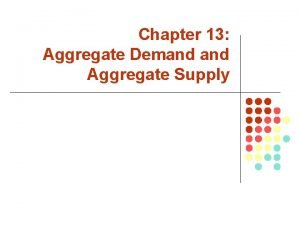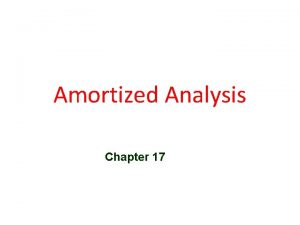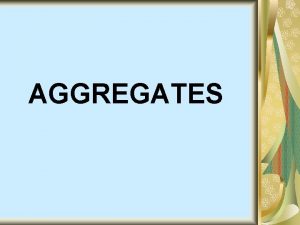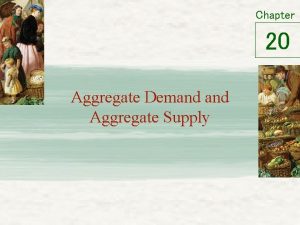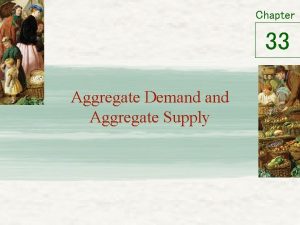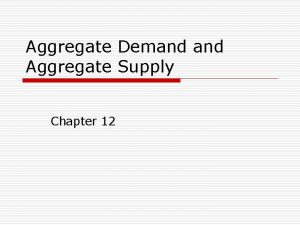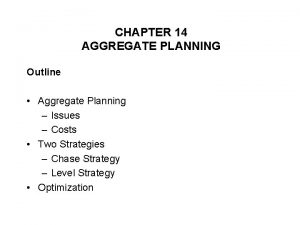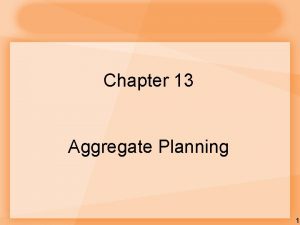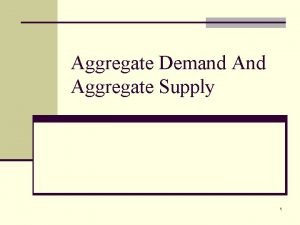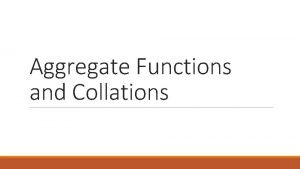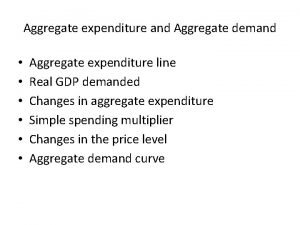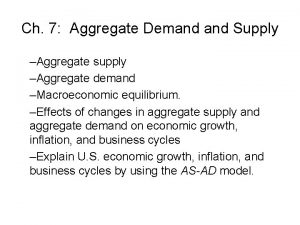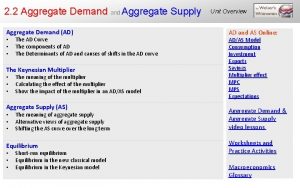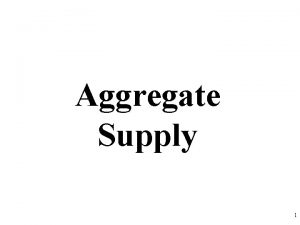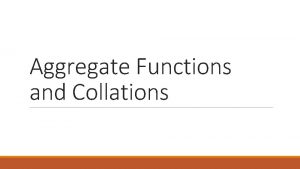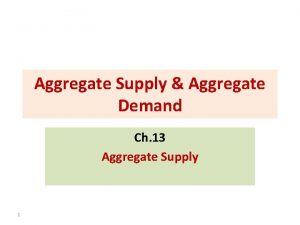Aggregate Planning Chapter 11 Aggregate Planning Aggregate planning




































































- Slides: 68

Aggregate Planning Chapter 11

Aggregate Planning • Aggregate planning – Intermediate-range capacity planning that typically covers a time horizon of 2 to 18 months. – Useful for organizations that experience seasonal, or other variations in demand. – “Big-picture” approach. Groups together similar products (services) and deals with them as though they were a single products (service). – Goal: • Achieve a production plan that will effectively utilize the organization’s resources to satisfy overall demand

The Planning Sequence Long-term planning Intermediate-term planning Short-term detailed planning

Aggregate Planning • The main idea behind aggregate planning: Aggregate planning translates business plans into rough labor schedules and production plans • Issues to consider for aggregate planning – Production rate: “aggregate units” per worker per unit time – Workforce level: available workforce in terms of hours – Actual production: Production rate x Workforce level – Inventory: Units carried over from previous periods – Costs: production, changing workforce, inventory

What does aggregate planning do? • Given an aggregate demand forecast, determine production levels, inventory levels, and workforce levels, in order to minimize total relevant costs over the planning horizon

Why do organizations need to do aggregate planning? • Planning – It takes time to implement plans (e. g. hiring). • Aggregation – It is not possible to predict with accuracy the timing and volume of demand for individual items. • Planning is connected to the budgeting process which is usually done annually on an aggregate (e. g. , departmental) level. • It can help synchronize flow throughout the supply chain; it affects costs, equipment utilization; employment levels; and customer satisfaction

Aggregate Planning Strategies • Proactive – Alter demand to match supply (capacity) – Among other approaches, we can alter demand by simply changing the price. • Reactive – Alter supply (capacity) to match demand – Through capacity planning and aggregate planning • Mixed – Some of each

Demand Options • Pricing – Used to shift demand from peak to off-peak periods. • Airline: night/weekend • Restaurants: happy hour/early bird – Price elasticity is important – Yield (Revenue) Management • Maximizing revenue by using a variable pricing strategy. Prices are set relative to capacity availability. • Promotion – Advertising and other forms of promotion – Issue: response rate and response patterns. Less control over timing of demand (may worsen the problem by bringing demand at the wrong time). • Back orders (delaying order filling) – Orders are taken in one period and deliveries promised for a later period – Possible loss of sales, increased record keeping, lowered customer service level • New demand – Very uneven situation – Offer different products/services during off-peak periods to make use of excess capacity: fastfood stores offer breakfast.

Supply Options • • • Hire and layoff workers – May have upper or lower limit – Unions/internal policies may prohibit layoffs – Skill levels, recruiting costs – Associated costs (e. g. , recruiting, training, severance-pay, morale) Overtime – Maintain skilled workforce; Seasonal peaks – Unions/Overtime may result in lower productivity, poorer quality, more accidents, increased payroll costs Part-time workers – Usually low-to-moderate job skills; Seasonal – Independent-contractors Inventories – Produce in one period and sell in another – Costs: holding and carrying cost, money tied up in inventory, insurance, obsolescence, deterioration, spoilage, breakage etc. Subcontracting New Demand – Less control over output. Quality problems. – Higher costs

Aggregate Planning Supply Strategies • Level capacity strategy: – Maintaining a steady rate of regular-time output; variations in demand are met by using inventories or other options such as overtime, part-time workers, subcontracting, and backorders • Chase demand strategy: – Matching capacity to demand; the planned output for a period is set at the expected demand for that period. MIS 373: Basic Operations Management 11

Level strategy • Capacities are kept constant over the planning horizon – Advantages • Stable output rates and workforce – Disadvantages • Greater inventory (or other) costs MIS 373: Basic Operations Management 12

Chase strategy • Capacities are adjusted to match demand requirements over the planning horizon – Advantages • Investment in inventory is low • Labor utilization in high – Disadvantages • The cost of adjusting output rates and/or workforce levels MIS 373: Basic Operations Management 13

Uneven Demand Two Strategies: Demand = Supply Demand < Supply Demand > Supply (output) level 11 -14

Choosing a Strategy • Important factors: – Company policy • Constraints on the available options – e. g. , discourage layoffs, no subcontracting to protects secrets, union policies regarding over time – Flexibility • Chase flexibility may not be present for companies designed for high steady output (e. g. , refineries, auto assembly) – Cost • Alternatives are evaluated in term of cost (while matching demand within the constraints). MIS 373: Basic Operations Management 15

Trial-and-Error Techniques • Trial-and-error approaches consist of developing simple table or graphs that enable planners to visually compare projected demand requirements with existing capacity • Alternatives are compared based on their total costs • Disadvantage: – it does not necessarily result in an optimal aggregate plan

Example #1: Chase demand • • Beginning Inventory: 0 units Beginning Workforce: 5 workers Production Rate: 10 units/worker/period Regular Production Costs: $10/unit Inventory Costs: $5/unit/period Hiring Cost: $200/worker Firing Cost: $100/worker Period 1 2 3 4 5 Demand 40 30 20 50 60 MIS 373: Basic Operations Management 17

Example #1: Chase demand Time Periods Beginning Inventory 0 Demand 1 2 3 4 5 Total 40 30 20 50 60 200 Production End Inventory # Hired # Fired # Hired in the beginning of a period # Fired in the Beginning Inventory: 0 units Beginning Workforce: 5 workers beginning of a period Production Rate: 10 units/worker/period Regular Production Costs: $10/unit Inventory Costs: $5/unit/period Hiring Cost: $200/worker MIS 373: Basic Operations Management 18 Firing Cost: $100/worker

Example #1: Chase demand 0 1 2 3 4 5 Total Demand 40 30 20 50 60 200 Production 40 30 20 50 60 200 End Inventory # Hired # Fired Beginning Inventory: 0 units Beginning Workforce: 5 workers Production Rate: 10 units/worker/period Regular Production Costs: $10/unit Inventory Costs: $5/unit/period Hiring Cost: $200/worker MIS 373: Basic Operations Management 19 Firing Cost: $100/worker Recall the chase strategy: Capacities are adjusted to match demand requirements over the planning horizon

Example #1: Chase demand 0 1 2 3 4 5 Total Demand 40 30 20 50 60 200 Production 40 30 20 50 60 200 End Inventory 0 # Hired 0 # Fired 1 Beginning Inventory: 0 units Beginning Workforce: 5 workers Production Rate: 10 units/worker/period Regular Production Costs: $10/unit Inventory Costs: $5/unit/period Hiring Cost: $200/worker MIS 373: Basic Operations Management 20 Firing Cost: $100/worker

Example #1: Chase demand 0 1 2 3 4 5 Total Demand 40 30 20 50 60 200 Production 40 30 20 50 60 200 End Inventory 0 0 # Hired 0 0 # Fired 1 1 Beginning Inventory: 0 units Beginning Workforce: 5 workers Production Rate: 10 units/worker/period Regular Production Costs: $10/unit Inventory Costs: $5/unit/period Hiring Cost: $200/worker MIS 373: Basic Operations Management 21 Firing Cost: $100/worker

Example #1: Chase demand 0 1 2 3 4 5 Total Demand 40 30 20 50 60 200 Production 40 30 20 50 60 200 End Inventory 0 0 0 # Hired 0 0 0 # Fired 1 1 1 Beginning Inventory: 0 units Beginning Workforce: 5 workers Production Rate: 10 units/worker/period Regular Production Costs: $10/unit Inventory Costs: $5/unit/period Hiring Cost: $200/worker MIS 373: Basic Operations Management 22 Firing Cost: $100/worker

Example #1: Chase demand 0 1 2 3 4 5 Total Demand 40 30 20 50 60 200 Production 40 30 20 50 60 200 End Inventory 0 0 # Hired 0 0 0 3 # Fired 1 1 1 0 Beginning Inventory: 0 units Beginning Workforce: 5 workers Production Rate: 10 units/worker/period Regular Production Costs: $10/unit Inventory Costs: $5/unit/period Hiring Cost: $200/worker MIS 373: Basic Operations Management 23 Firing Cost: $100/worker

Example #1: Chase demand 0 1 2 3 4 5 Total Demand 40 30 20 50 60 200 Production 40 30 20 50 60 200 End Inventory 0 0 0 # Hired 0 0 0 3 1 # Fired 1 1 1 0 0 Beginning Inventory: 0 units Beginning Workforce: 5 workers Production Rate: 10 units/worker/period Regular Production Costs: $10/unit Inventory Costs: $5/unit/period Hiring Cost: $200/worker MIS 373: Basic Operations Management 24 Firing Cost: $100/worker

Example #1: Chase demand 0 1 2 3 4 5 Total Demand 40 30 20 50 60 200 Production 40 30 20 50 60 200 End Inventory 0 0 0 # Hired 0 0 0 3 1 4 # Fired 1 1 1 0 0 3 Beginning Inventory: 0 units Beginning Workforce: 5 workers Production Rate: 10 units/worker/period Regular Production Costs: $10/unit Inventory Costs: $5/unit/period Hiring Cost: $200/worker MIS 373: Basic Operations Management 25 Firing Cost: $100/worker

Example #1: Chase demand 0 1 2 3 4 5 Total Demand 40 30 20 50 60 200 Production 40 30 20 50 60 200 End Inventory 0 0 0 # Hired 0 0 0 3 1 4 # Fired 1 1 1 0 0 3 Beginning Inventory: 0 units Beginning Workforce: 5 workers Production Rate: 10 units/worker/period Regular Production Costs: $10/unit Inventory Costs: $5/unit/period Hiring Cost: $200/worker MIS 373: Basic Operations Management 26 Firing Cost: $100/worker One defining characteristics of the chase strategy is that we don’t have end inventory. All we produced are/were sold. No holding cost

Example #1: Chase demand 0 1 2 3 4 5 Total Demand 40 30 20 50 60 200 Production 40 30 20 50 60 200 End Inventory 0 0 0 # Hired 0 0 0 3 1 4 # Fired 1 1 1 0 0 3 TC=Production + Holding = 200*10 + 0 Beginning Inventory: 0 units Beginning Workforce: 5 workers + Hiring + Firing Production Rate: 10 units/worker/period + 4*200 + 3*100 = $3, 100 Regular Production Costs: $10/unit Inventory Costs: $5/unit/period Hiring Cost: $200/worker MIS 373: Basic Operations Management 27 Firing Cost: $100/worker

Exercise • Perform aggregate planning using the chase strategy: – – – – Beginning Inventory: 10 units Beginning Workforce: 5 workers Production Rate: 10 units/worker/period Regular Production Costs: $10/unit Inventory Costs: $10/unit/period Hiring Cost: $100/worker Firing Cost: $200/worker Period 1 2 3 4 5 Demand 50 40 30 30 40

Solution Beginning Inventory 10 Demand 1 2 3 4 5 Total 50 40 30 30 40 190 Production End Inventory # Hired # Fired Beginning Inventory: 10 units Beginning Workforce: 5 workers Production Rate: 10 units/worker/period Regular Production Costs: $10/unit Inventory Costs: $10/unit/period Hiring Cost: $100/worker Firing Cost: $200/worker

Solution Beginning Inventory 10 1 2 3 4 5 Total Demand 50 40 30 30 40 190 Production 40 40 30 30 40 180 End Inventory # Hired # Fired We only produce 40 units because there are 10 units beginning inventory that we can use. So, we can still meet the demand of 50 units. Beginning Inventory: 10 units Beginning Workforce: 5 workers Production Rate: 10 units/worker/period Regular Production Costs: $10/unit Inventory Costs: $10/unit/period Hiring Cost: $100/worker Firing Cost: $200/worker

Solution Beginning Inventory 10 1 2 3 4 5 Total Demand 50 40 30 30 40 190 Production 40 40 30 30 40 180 End Inventory 0 # Hired 0 # Fired 1 The beginning workforce is 5 workers. Since we only produce 40 units in this period and each worker can handle 10 units in a period, we only need 4 works here. We hence fire 1 at the beginning of this period. Beginning Inventory: 10 units Beginning Workforce: 5 workers Production Rate: 10 units/worker/period Regular Production Costs: $10/unit Inventory Costs: $10/unit/period Hiring Cost: $100/worker Firing Cost: $200/worker

Solution 10 1 2 3 4 5 Total Demand 50 40 30 30 40 190 Production 40 40 30 30 40 180 End Inventory 0 0 # Hired 0 0 # Fired 1 0 Beginning Inventory: 10 units Beginning Workforce: 5 workers Production Rate: 10 units/worker/period Regular Production Costs: $10/unit Inventory Costs: $10/unit/period Hiring Cost: $100/worker Firing Cost: $200/worker

Solution 10 1 2 3 4 5 Total Demand 50 40 30 30 40 190 Production 40 40 30 30 40 180 End Inventory 0 0 0 # Hired 0 0 0 # Fired 1 0 1 Beginning Inventory: 10 units Beginning Workforce: 5 workers Production Rate: 10 units/worker/period Regular Production Costs: $10/unit Inventory Costs: $10/unit/period Hiring Cost: $100/worker Firing Cost: $200/worker

Solution 10 1 2 3 4 5 Total Demand 50 40 30 30 40 190 Production 40 40 30 30 40 180 End Inventory 0 0 # Hired 0 0 # Fired 1 0 Beginning Inventory: 10 units Beginning Workforce: 5 workers Production Rate: 10 units/worker/period Regular Production Costs: $10/unit Inventory Costs: $10/unit/period Hiring Cost: $100/worker Firing Cost: $200/worker

Solution 10 1 2 3 4 5 Total Demand 50 40 30 30 40 190 Production 40 40 30 30 40 180 End Inventory 0 0 0 # Hired 0 0 1 1 # Fired 1 0 0 2 Beginning Inventory: 10 units Beginning Workforce: 5 workers Production Rate: 10 units/worker/period Regular Production Costs: $10/unit Inventory Costs: $10/unit/period Hiring Cost: $100/worker Firing Cost: $200/worker

Solution 10 1 2 3 4 5 Total Demand 50 40 30 30 40 190 Production 40 40 30 30 40 180 End Inventory 0 0 0 # Hired 0 0 1 1 # Fired 1 0 0 2 TC=Production + Holding + Hiring + Firing = 180*10 + 5*10 + 1*100 + 2*200 Beginning Inventory: 10 units Beginning Workforce: 5 workers Production Rate: 10 units/worker/period Regular Production Costs: $10/unit Inventory Costs: $10/unit/period Hiring Cost: $100/worker Firing Cost: $200/worker

Example #2: Level Capacity 0 Demand 1 2 3 4 5 Total 40 30 20 50 60 200 Production End Inventory # Hired # Fired Beginning Inventory: 0 units Beginning Workforce: 5 workers Production Rate: 10 units/worker/period Regular Production Costs: $10/unit Inventory Holding Costs: $5/unit/period Hiring Cost: $200/worker MIS 373: Basic Operations Management 37 Firing Cost: $100/worker

Example #2: Level Capacity 0 1 2 3 4 5 Total Demand 40 30 20 50 60 200 Production 40 40 40 200 End Inventory # Hired # Fired Recall the level strategy: Capacities are kept constant over the planning horizon. So, Beginning Inventory: 0 units Beginning Workforce: 5 workers Production Rate: 10 units/worker/period Regular Production Costs: $10/unit Total demand=40+30+20+50+60=200 Inventory Holding Costs: $5/unit/period Production period=200/5=40 Hiring Cost: $200/worker MIS 373: Basic Operations Management 38 Firing Cost: $100/worker

Example #2: Level Capacity 0 1 2 3 4 5 Total Demand 40 30 20 50 60 200 Production 40 40 40 200 End Inventory 0 # Hired 0 # Fired 1 Beginning Inventory: 0 units Beginning Workforce: 5 workers Production Rate: 10 units/worker/period Regular Production Costs: $10/unit Inventory Holding Costs: $5/unit/period Hiring Cost: $200/worker MIS 373: Basic Operations Management 39 Firing Cost: $100/worker

Example #2: Level Capacity 0 1 2 3 4 5 Total Demand 40 30 20 50 60 200 Production 40 40 40 200 End Inventory 0 # Hired 0 # Fired 1 Fire 1 worker in this period because 4 workers are sufficient to produce 40 units in a period. Beginning Inventory: 0 units Beginning Workforce: 5 workers Production Rate: 10 units/worker/period Regular Production Costs: $10/unit Inventory Holding Costs: $5/unit/period Hiring Cost: $200/worker MIS 373: Basic Operations Management 40 Firing Cost: $100/worker

Example #2: Level Capacity 0 1 2 3 4 5 Total Demand 40 30 20 50 60 200 Production 40 40 40 200 End Inventory 0 10 # Hired 0 0 # Fired 1 0 Beginning Inventory: 0 units Beginning Workforce: 5 workers Production Rate: 10 units/worker/period Regular Production Costs: $10/unit Inventory Holding Costs: $5/unit/period Hiring Cost: $200/worker MIS 373: Basic Operations Management 41 Firing Cost: $100/worker

Example #2: Level Capacity 0 1 2 3 4 5 Total Demand 40 30 20 50 60 200 Production 40 40 40 200 End Inventory 0 10 30 # Hired 0 0 0 # Fired 1 0 0 Beginning Inventory: 0 units Beginning Workforce: 5 workers Production Rate: 10 units/worker/period Regular Production Costs: $10/unit Inventory Holding Costs: $5/unit/period Hiring Cost: $200/worker MIS 373: Basic Operations Management 42 Firing Cost: $100/worker

Example #2: Level Capacity 0 1 2 3 4 5 Total Demand 40 30 20 50 60 200 Production 40 40 40 200 End Inventory 0 10 30 20 # Hired 0 0 # Fired 1 0 0 0 Beginning Inventory: 0 units Beginning Workforce: 5 workers Production Rate: 10 units/worker/period Regular Production Costs: $10/unit Inventory Holding Costs: $5/unit/period Hiring Cost: $200/worker MIS 373: Basic Operations Management 43 Firing Cost: $100/worker

Example #2: Level Capacity 0 1 2 3 4 5 Total Demand 40 30 20 50 60 200 Production 40 40 40 200 End Inventory 0 10 30 20 0 # Hired 0 0 0 # Fired 1 0 0 Beginning Inventory: 0 units Beginning Workforce: 5 workers Production Rate: 10 units/worker/period Regular Production Costs: $10/unit Inventory Holding Costs: $5/unit/period Hiring Cost: $200/worker MIS 373: Basic Operations Management 44 Firing Cost: $100/worker

Example #2: Level Capacity 0 1 2 3 4 5 Total Demand 40 30 20 50 60 200 Production 40 40 40 200 End Inventory 0 10 30 20 0 60 # Hired 0 0 0 # Fired 1 0 0 1 Beginning Inventory: 0 units Beginning Workforce: 5 workers Production Rate: 10 units/worker/period Regular Production Costs: $10/unit Inventory Holding Costs: $5/unit/period Hiring Cost: $200/worker MIS 373: Basic Operations Management 45 Firing Cost: $100/worker

Example #2: Level Capacity 0 1 2 3 4 5 Total Demand 40 30 20 50 60 200 Production 40 40 40 200 End Inventory 0 10 30 20 0 60 # Hired 0 0 0 # Fired 1 0 0 1 One defining characteristics of the level strategy is that we don’t need to adjust capacity (here, labor force), except for the initial period. Beginning Inventory: 0 units Beginning Workforce: 5 workers Production Rate: 10 units/worker/period Regular Production Costs: $10/unit Inventory Holding Costs: $5/unit/period Hiring Cost: $200/worker MIS 373: Basic Operations Management 46 Firing Cost: $100/worker

Example #2: Level Capacity 0 1 2 3 4 5 Total Demand 40 30 20 50 60 200 Production 40 40 40 200 End Inventory 0 10 30 20 0 60 # Hired 0 0 0 # Fired 1 0 0 1 TC=Production + Holding + Hiring + Firing But, how to calculate Average inventory Beginning Inventory: 0 units Beginning Workforce: 5 workers Production Rate: 10 units/worker/period the holding cost? Regular Production Costs: $10/unit Inventory Holding Costs: $5/unit/period in a period Hiring Cost: $200/worker MIS 373: Basic Operations Management 47 Firing Cost: $100/worker

Example #2: Level Capacity 0 Regular Production Costs: $10/unit 1 2 3 4 5 Total Demand 40 30 20 50 60 200 Production 40 40 40 200 End Inventory 0 10 30 20 0 60 Hiring Cost: $200/worker Average Inventory 0 Firing Cost: $100/worker # Hired # Fired 5 20 25 10 60 =(0+10)/2 =(10+30)/2 0 0 0 1 Inventory Holding Costs: $5/unit/period We can estimate the holding cost by considering the average inventory in each period. MIS 373: Basic Operations Management 48

Example #2: Level Capacity 0 Regular Production Costs: $10/unit 1 2 3 4 5 Total Demand 40 30 20 50 60 200 Production 40 40 40 200 End Inventory 0 10 30 20 0 60 Hiring Cost: $200/worker Average Inventory 0 Firing Cost: $100/worker # Hired # Fired 5 20 25 10 60 =(0+10)/2 =(10+30)/2 0 0 0 1 Inventory Holding Costs: $5/unit/period TC=Production + Holding + Hiring + Firing TC= 200*10 + 60*5 + 0*200 + 1*100 = $2, 400 MIS 373: Basic Operations Management 49

Example #2: Level Capacity 0 Regular Production Costs: $10/unit 1 2 3 4 5 Total Demand 40 30 20 50 60 200 Production 40 40 40 200 End Inventory 0 10 30 20 0 60 Hiring Cost: $200/worker Average Inventory 0 Firing Cost: $100/worker # Hired # Fired 5 20 25 10 60 =(0+10)/2 =(10+30)/2 0 0 0 1 Inventory Holding Costs: $5/unit/period TC=Production + Holding + Hiring + Firing TC= 200*10 + 60*5 + 0*200 + 1*100 = $2, 400 MIS 373: Basic Operations Management 50

Exercise • Perform aggregate planning using the level strategy: • • Beginning Inventory: 10 units Beginning Workforce: 5 workers Production Rate: 10 units/worker/period Regular Production Costs: $10/unit Inventory Costs: $10/unit/period Hiring Cost: $100/worker Firing Cost: $200/worker Period 1 2 3 4 5 Demand 50 40 30 30 40 Two additional assumptions: 1. Unmet demands in a period can be held and fulfilled in a future period. 2. There is no cost associated with unmet demands.

Solution Beginning Inventory 10 Demand 1 2 3 4 5 Total 50 40 30 30 40 190 Production End Inventory Avg. Inventory # Hired # Fired Beginning Inventory: 10 units Beginning Workforce: 5 workers Production Rate: 10 units/worker/period Regular Production Costs: $10/unit Inventory Costs: $10/unit/period Hiring Cost: $100/worker Firing Cost: $200/worker

Solution Beginning Inventory 10 1 2 3 4 5 Total Demand 50 40 30 30 40 190 Production 36 36 36 180 End Inventory Avg. Inventory # Hired # Fired Total demand=190 – 10 = 180 Production period=180/5=36 Beginning Inventory: 10 units Beginning Workforce: 5 workers Production Rate: 10 units/worker/period Regular Production Costs: $10/unit Inventory Costs: $10/unit/period Hiring Cost: $100/worker Firing Cost: $200/worker

Solution Beginning Inventory 10 1 2 3 4 5 Total Demand 50 40 30 30 40 190 Production 36 36 36 180 End Inventory -4 Avg. Inventory 3 # Hired 0 # Fired 1 By assumption #1, unmet demands in a period can be held and fulfilled in a future period. So, we keep track on the unmet demands, and try to fulfill them in a future period. Beginning Inventory: 10 units Beginning Workforce: 5 workers Production Rate: 10 units/worker/period Regular Production Costs: $10/unit Inventory Costs: $10/unit/period Hiring Cost: $100/worker Firing Cost: $200/worker

Solution Beginning Inventory 10 1 2 3 4 5 Total Demand 50 40 30 30 40 190 Production 36 36 36 180 End Inventory -4 Avg. Inventory 3 # Hired 0 # Fired 1 Avg. inventory = [10 + (-4)]/2 = 3 Beginning Inventory: 10 units Beginning Workforce: 5 workers Production Rate: 10 units/worker/period Regular Production Costs: $10/unit Inventory Costs: $10/unit/period Hiring Cost: $100/worker Firing Cost: $200/worker

Solution Beginning Inventory 10 1 2 3 4 5 Total Demand 50 40 30 30 40 190 Production 36 36 36 180 End Inventory -4 -8 Avg. Inventory 3 -6 # Hired 0 0 # Fired 1 0 -8 = (-4) + (-4) Unmet demand from period #1 and from period #2 Beginning Inventory: 10 units Beginning Workforce: 5 workers Production Rate: 10 units/worker/period Regular Production Costs: $10/unit Inventory Costs: $10/unit/period Hiring Cost: $100/worker Firing Cost: $200/worker

Solution Beginning Inventory 10 1 2 3 4 5 Total Demand 50 40 30 30 40 190 Production 36 36 36 180 End Inventory -4 -8 -2 Avg. Inventory 3 -6 -5 # Hired 0 0 0 # Fired 1 0 0 Beginning Inventory: 10 units Beginning Workforce: 5 workers Production Rate: 10 units/worker/period Regular Production Costs: $10/unit Inventory Costs: $10/unit/period Hiring Cost: $100/worker Firing Cost: $200/worker

Solution Beginning Inventory 10 1 2 3 4 5 Total Demand 50 40 30 30 40 190 Production 36 36 36 180 End Inventory -4 -8 -2 4 Avg. Inventory 3 -6 -5 1 # Hired 0 0 # Fired 1 0 0 0 Beginning Inventory: 10 units Beginning Workforce: 5 workers Production Rate: 10 units/worker/period Regular Production Costs: $10/unit Inventory Costs: $10/unit/period Hiring Cost: $100/worker Firing Cost: $200/worker

Solution Beginning Inventory 10 1 2 3 4 5 Total Demand 50 40 30 30 40 190 Production 36 36 36 180 End Inventory -4 -8 -2 4 0 Avg. Inventory 3 -6 -5 1 2 # Hired 0 0 0 # Fired 1 0 0 1 Beginning Inventory: 10 units Beginning Workforce: 5 workers Production Rate: 10 units/worker/period Regular Production Costs: $10/unit Inventory Costs: $10/unit/period Hiring Cost: $100/worker Firing Cost: $200/worker

Solution Beginning Inventory 10 1 2 3 4 5 Total Demand 50 40 30 30 40 190 Production 36 36 36 180 End Inventory -4 -8 -2 4 0 Avg. Inventory 3 -6 -5 1 2 # Hired 0 0 0 # Fired 1 0 0 1 Negative Inventory has no meaning! By assumption #2, there is no cost associated with unmet demand (i. e. , negative inventory has no Beginning Inventory: 10 units costs). Beginning Workforce: 5 workers TC=Production + Holding + Hiring + Firing = 180*10 + 10*(3+1+2) + 0 + 1*200 = $2, 030 Production Rate: 10 units/worker/period Regular Production Costs: $10/unit Inventory Costs: $10/unit/period Hiring Cost: $100/worker Firing Cost: $200/worker

Solution 10 1 2 3 4 5 Total Demand 50 40 30 30 40 190 Production 36 36 36 180 End Inventory Avg. Inventory # Hired # Fired Another way to solve this problem. Pushing unmet demands to its next period Beginning Inventory: 10 units Beginning Workforce: 5 workers Production Rate: 10 units/worker/period Regular Production Costs: $10/unit Inventory Costs: $10/unit/period Hiring Cost: $100/worker Firing Cost: $200/worker

Solution 10 1 2 3 4 5 Total Demand 50 40 44 30 30 40 190 Production 36 36 36 180 End Inventory 0 Avg. Inventory 5 # Hired 0 # Fired 1 Another way to solve this problem. Pushing unmet demands to its next period Instead of -4 end inventory, here we have 0. See that the demand for period #2 increase from 40 to 44. Beginning Inventory: 10 units Beginning Workforce: 5 workers Production Rate: 10 units/worker/period Regular Production Costs: $10/unit Inventory Costs: $10/unit/period Hiring Cost: $100/worker Firing Cost: $200/worker

Solution 10 1 2 3 4 5 Total Demand 50 40 44 30 38 30 40 190 Production 36 36 36 180 End Inventory 0 0 Avg. Inventory 5 0 # Hired 0 0 # Fired 1 0 Beginning Inventory: 10 units Beginning Workforce: 5 workers Production Rate: 10 units/worker/period Regular Production Costs: $10/unit Inventory Costs: $10/unit/period Hiring Cost: $100/worker Firing Cost: $200/worker

Solution 10 1 2 3 4 5 Total Demand 50 40 44 30 38 30 32 40 190 Production 36 36 36 180 End Inventory 0 0 0 Avg. Inventory 5 0 0 # Hired 0 0 0 # Fired 1 0 0 Beginning Inventory: 10 units Beginning Workforce: 5 workers Production Rate: 10 units/worker/period Regular Production Costs: $10/unit Inventory Costs: $10/unit/period Hiring Cost: $100/worker Firing Cost: $200/worker

Solution 10 1 2 3 4 5 Total Demand 50 40 44 30 38 30 32 40 190 Production 36 36 36 180 End Inventory 0 0 0 4 Avg. Inventory 5 0 0 2 # Hired 0 0 # Fired 1 0 0 0 Beginning Inventory: 10 units Beginning Workforce: 5 workers Production Rate: 10 units/worker/period Regular Production Costs: $10/unit Inventory Costs: $10/unit/period Hiring Cost: $100/worker Firing Cost: $200/worker

Solution 10 1 2 3 4 5 Total Demand 50 40 44 30 38 30 32 40 190 Production 36 36 36 180 End Inventory 0 0 0 4 Avg. Inventory 5 0 0 2 2 9 # Hired 0 0 0 # Fired 1 0 0 1 Beginning Inventory: 10 units Beginning Workforce: 5 workers Production Rate: 10 units/worker/period Regular Production Costs: $10/unit Inventory Costs: $10/unit/period Hiring Cost: $100/worker Firing Cost: $200/worker

Solution 10 1 2 3 4 5 Total Demand 50 40 44 30 38 30 32 40 190 Production 36 36 36 180 End Inventory 0 0 0 4 Avg. Inventory 5 0 0 2 2 9 # Hired 0 0 0 # Fired 1 0 0 1 TC=Production + Holding + Hiring + Firing = 180*10 + 10*9 + 0 + 1*200 = $2, 090 While the TC number is different, this approach seems more intuitive than the previous approach, especially on the parts about inventory. Beginning Inventory: 10 units Beginning Workforce: 5 workers Production Rate: 10 units/worker/period Regular Production Costs: $10/unit Inventory Costs: $10/unit/period Hiring Cost: $100/worker Firing Cost: $200/worker

Aggregate Planning in Services • The aggregate planning process is different for services in the following ways: – Most services cannot be inventoried – Demand for services is difficult to predict – Capacity is also difficult to predict – Service capacity must be provided at the appropriate place and time – Labor is usually the most constraining resource for services MIS 373: Basic Operations Management 68

Aggregate Planning in Services • Hospitals: – allocate funds, staff, and supplies to meet the demands of patients for their medical services • Restaurants: – smoothing the service rate, determining workforce size, and managing demand to match a fixed capacity – Perishable inventory • Airlines: – complex due to the large number of factors involved (planes, flight & group personnel, multiple routes, airports etc. ) – Capacity decisions must also take into account the percentage of seats to be allocated to various fare classes in order to maximize profit or yield (Revenue Management) MIS 373: Basic Operations Management 69
 Chapter 33 aggregate demand and aggregate supply
Chapter 33 aggregate demand and aggregate supply Perencanaan kapasitas dan agregat
Perencanaan kapasitas dan agregat List the strategic objectives of aggregate planning
List the strategic objectives of aggregate planning Capacity aggregation example
Capacity aggregation example How to calculate aggregate demand
How to calculate aggregate demand Cannot mix aggregate and non aggregate tableau
Cannot mix aggregate and non aggregate tableau Unit 3 aggregate demand and aggregate supply
Unit 3 aggregate demand and aggregate supply Unit 3 aggregate demand aggregate supply and fiscal policy
Unit 3 aggregate demand aggregate supply and fiscal policy Unit 3 aggregate demand aggregate supply and fiscal policy
Unit 3 aggregate demand aggregate supply and fiscal policy Sales and operations planning
Sales and operations planning The chase strategy
The chase strategy Aggregate planning inputs and outputs
Aggregate planning inputs and outputs Chase aggregate plan
Chase aggregate plan Red tomato tools case study excel
Red tomato tools case study excel Aggregate planning objectives
Aggregate planning objectives Aggregate planning excel solver
Aggregate planning excel solver Disadvantages of aggregate planning
Disadvantages of aggregate planning Aggregate planning formula
Aggregate planning formula Aggregate planning definition
Aggregate planning definition Aggregate planners seek to match supply and demand
Aggregate planners seek to match supply and demand Role of aggregate planning
Role of aggregate planning Inputs and outputs of aggregate planning
Inputs and outputs of aggregate planning Aggregate planning operations management
Aggregate planning operations management S&op powerpoint presentation
S&op powerpoint presentation Chase strategy example
Chase strategy example Conclusion of aggregate planning
Conclusion of aggregate planning Frozen slushy liquid time fences
Frozen slushy liquid time fences Aggregate of chapter 6
Aggregate of chapter 6 Shift in sras curve
Shift in sras curve Aggregate of chapter 6
Aggregate of chapter 6 Strategic planning vs tactical planning
Strategic planning vs tactical planning Goal achievement matrix
Goal achievement matrix Scenario planning workforce planning
Scenario planning workforce planning N planning
N planning Short term planning and long term planning
Short term planning and long term planning Language planning and policy slideshare
Language planning and policy slideshare Why is aggregate demand downward sloping
Why is aggregate demand downward sloping Sticky wage model
Sticky wage model Solow's model
Solow's model Aggregate supply equation
Aggregate supply equation Specific gravity formula in terms of density
Specific gravity formula in terms of density Sace scaling
Sace scaling Preplaced aggregate concrete
Preplaced aggregate concrete Fisher's equation
Fisher's equation Sql nested aggregate functions
Sql nested aggregate functions Aggregate price index formula
Aggregate price index formula Maximum aggregate size
Maximum aggregate size Capital deepening examples
Capital deepening examples Poorly graded aggregate
Poorly graded aggregate Grading of aggregates
Grading of aggregates Introduction to hydroponics
Introduction to hydroponics Aggregate demand curve
Aggregate demand curve Definition of fruits and vegetables
Definition of fruits and vegetables How does a fruit form
How does a fruit form Effective aggregate design
Effective aggregate design Sieve analysis of fine aggregate ppt
Sieve analysis of fine aggregate ppt Recessionary gap aggregate demand
Recessionary gap aggregate demand Lecture about flowers
Lecture about flowers The aggregate supply curve is
The aggregate supply curve is Aggregate supply and demand graph
Aggregate supply and demand graph The equilibrium level of real gdp
The equilibrium level of real gdp Aggregate expenditure function
Aggregate expenditure function The aggregate real money demand schedule l(r,y)
The aggregate real money demand schedule l(r,y) The aggregate real money demand schedule l(r,y)
The aggregate real money demand schedule l(r,y) Aggregate operation plan of resources for a restaurant
Aggregate operation plan of resources for a restaurant Aggregate supply shifters
Aggregate supply shifters Aggregate expenditure model
Aggregate expenditure model Define amortized analysis
Define amortized analysis Nadeem asghar
Nadeem asghar









